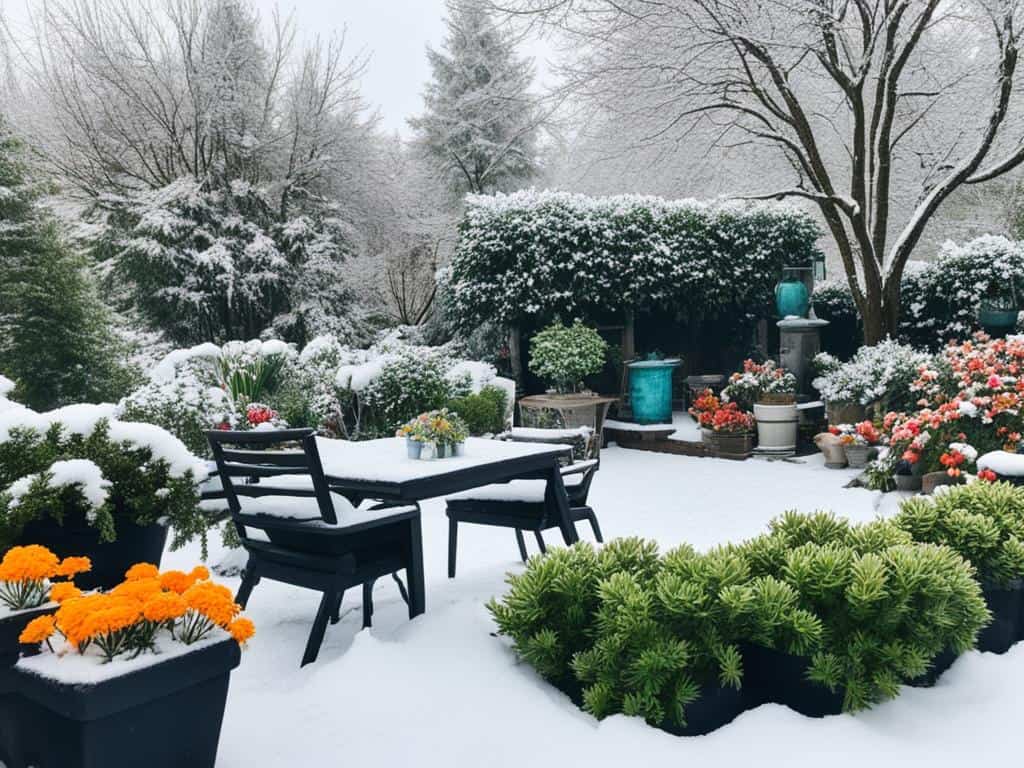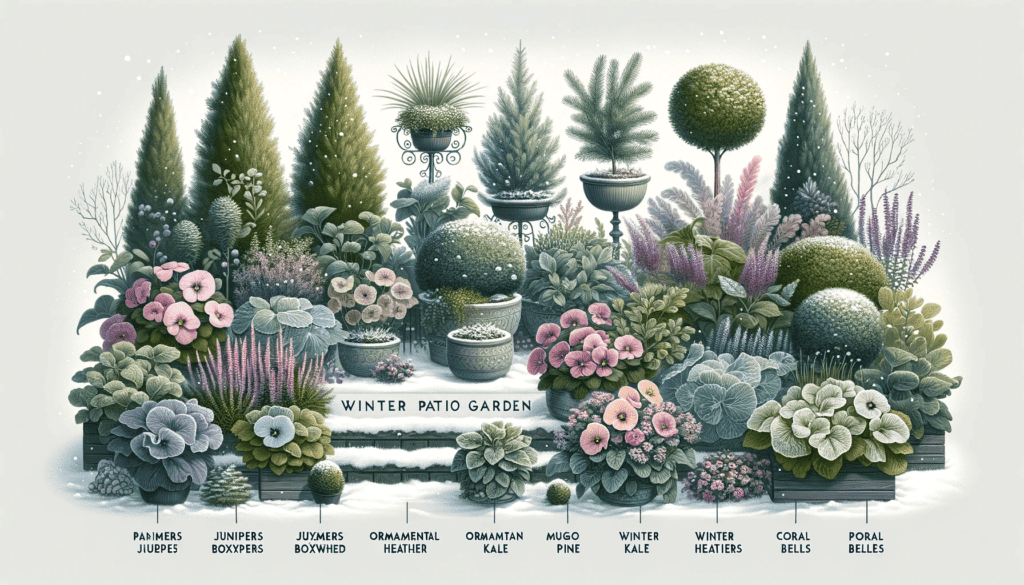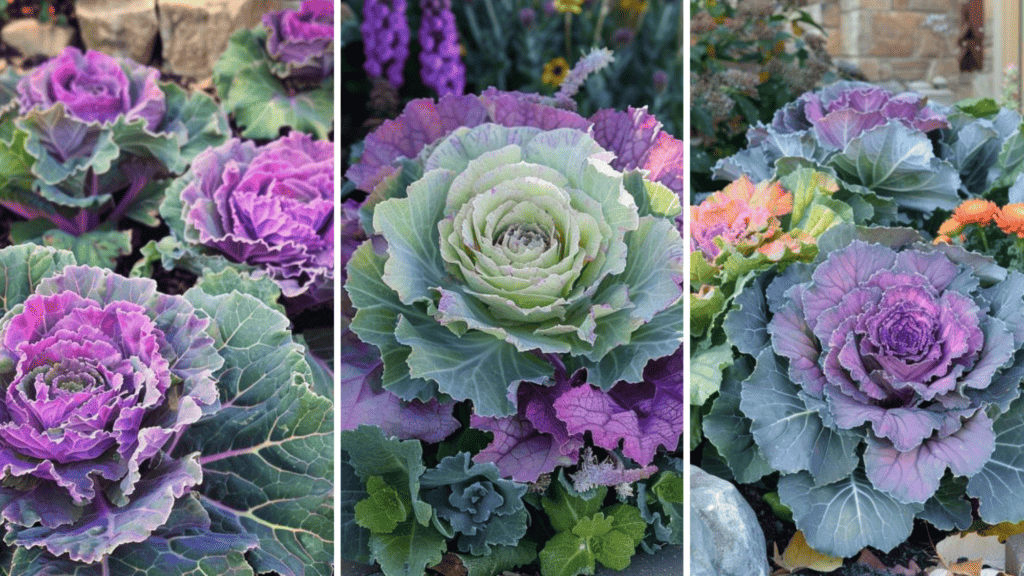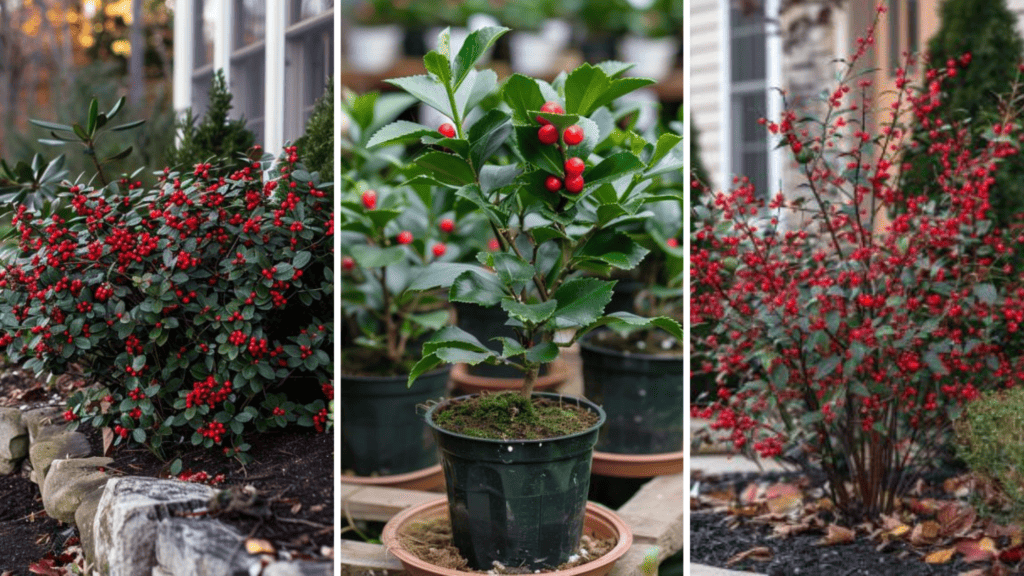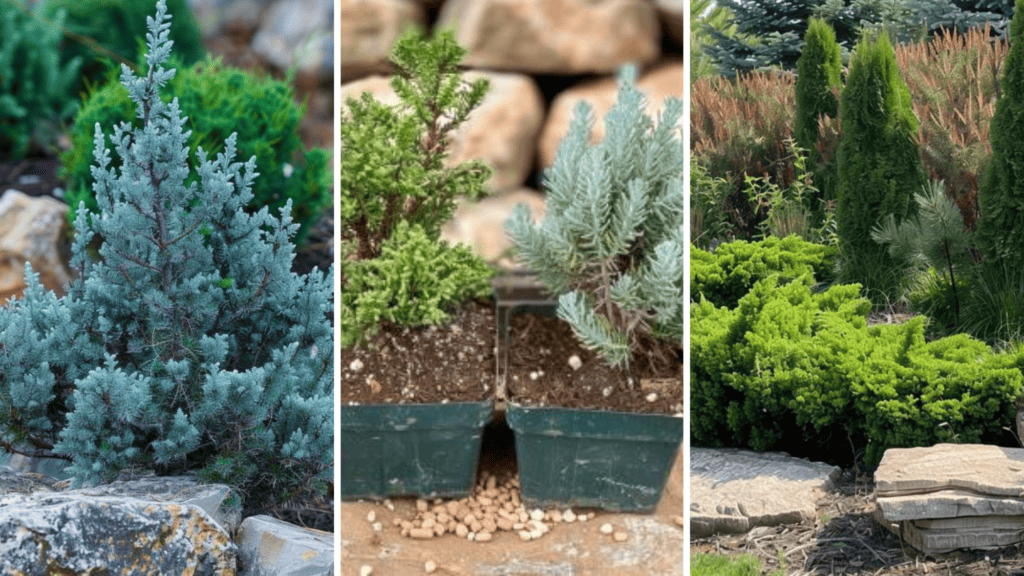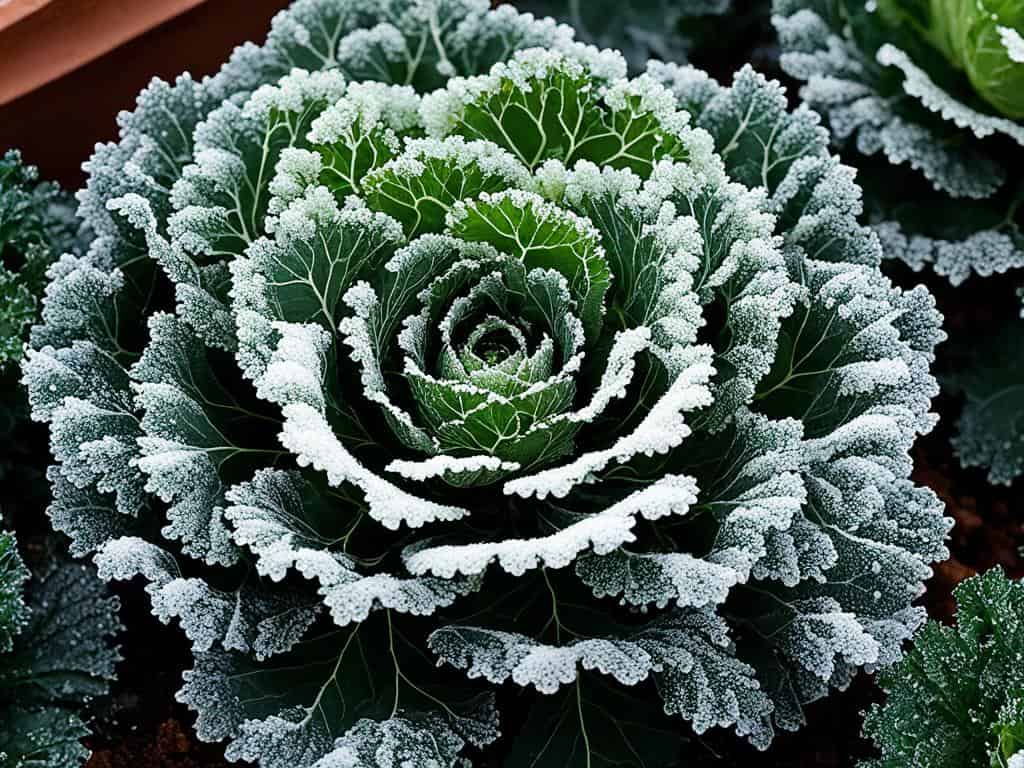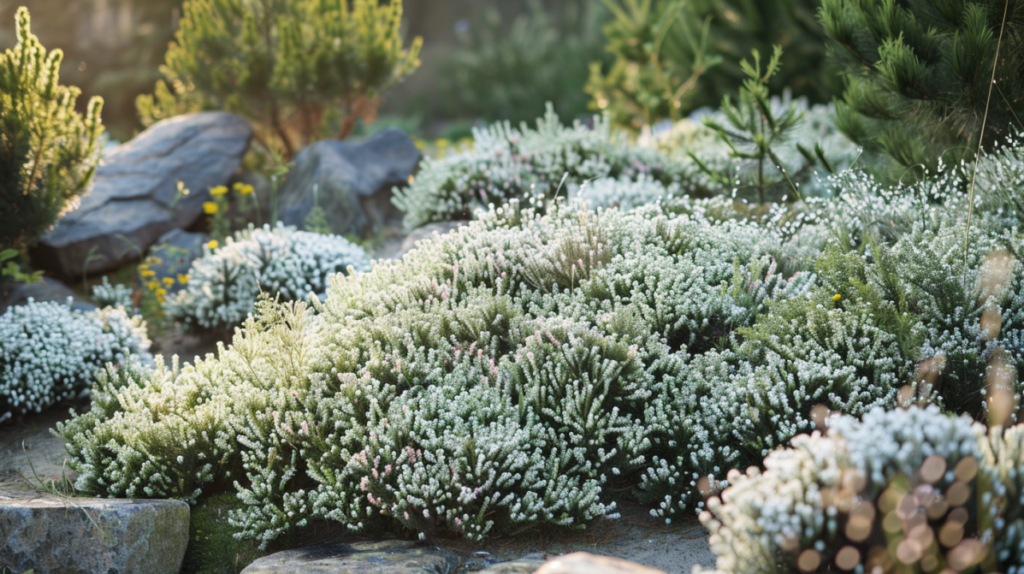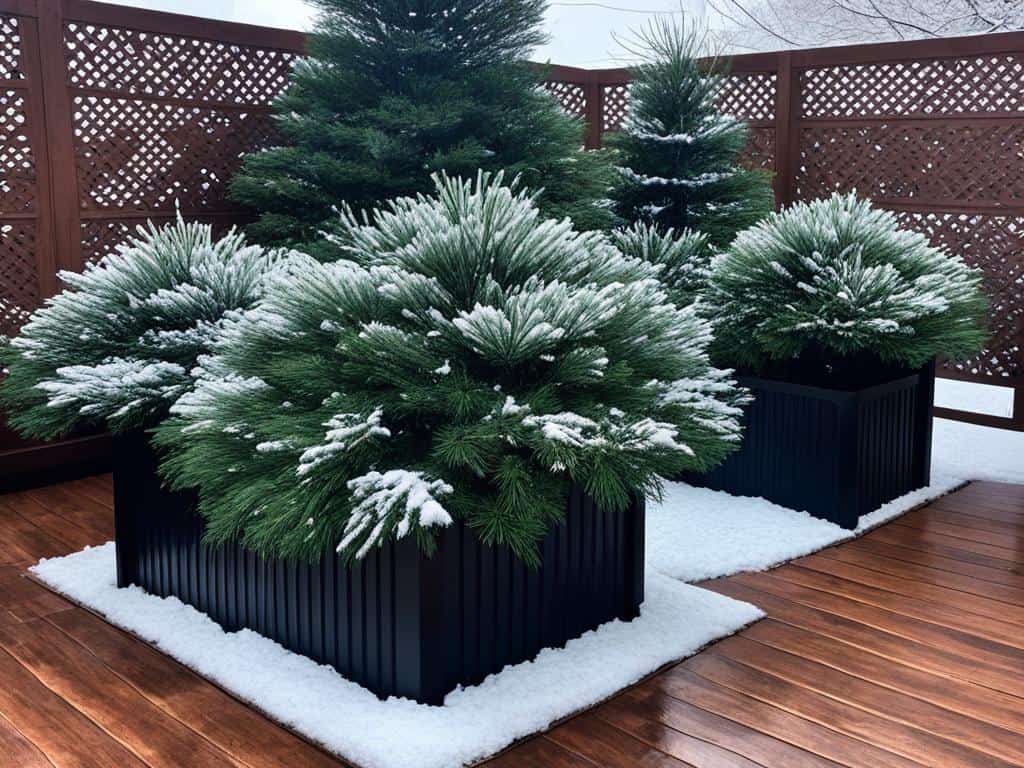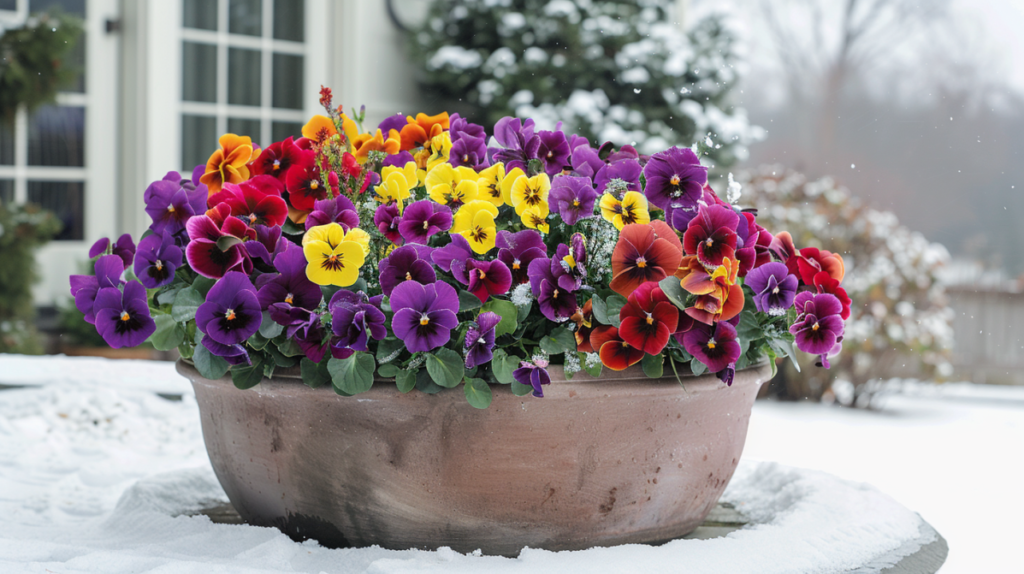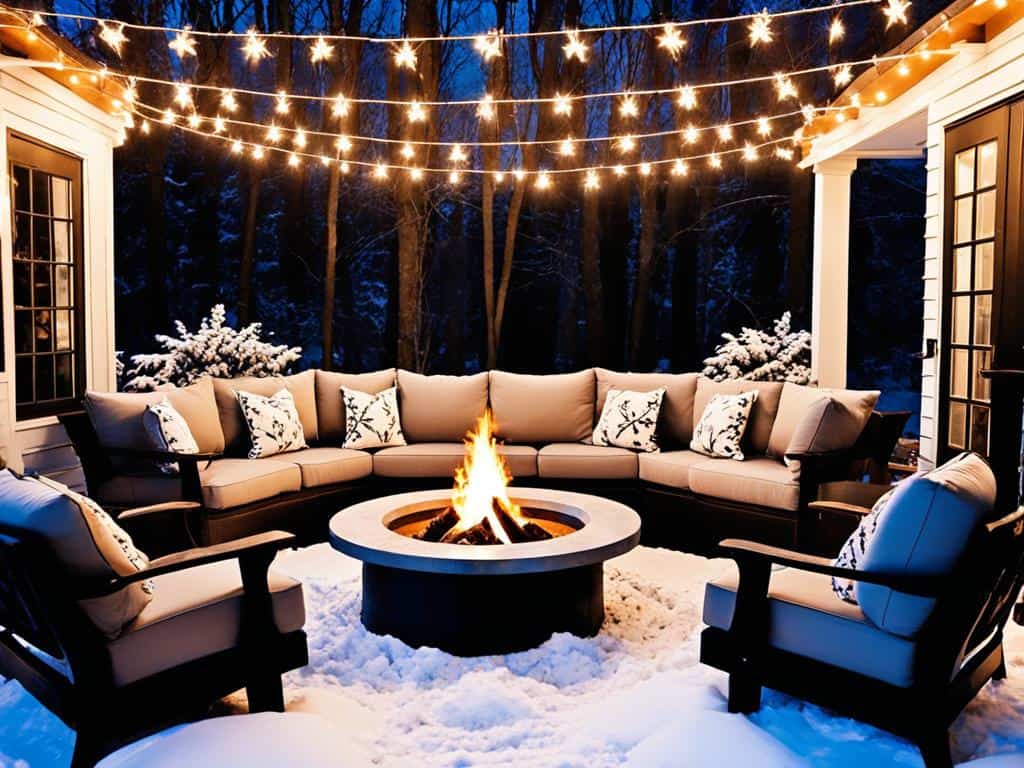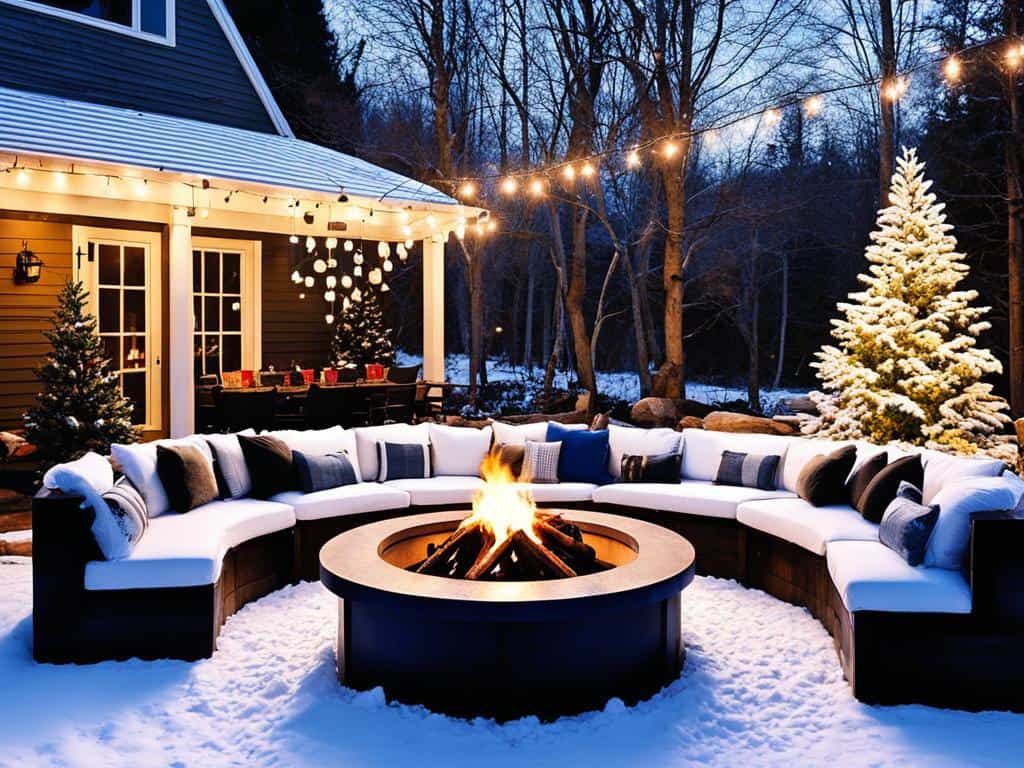Winter patio gardening is a wonderful way to bring life and vibrancy to your outdoor space, even during the chilly months. By selecting cold-weather plants that can withstand frost and low temperatures, you can create a lush and colorful patio garden that thrives all winter long. In this article, we will explore various cold-tolerant plants and container gardening tips to help you transform your patio into a beautiful and cozy winter oasis.
Key Takeaways:
- Winter patio gardening allows you to enjoy a flourishing outdoor space even in cold weather.
- Choose cold-weather plants that can withstand freezing temperatures and continue to thrive.
- Consider the USDA hardiness zone and plant suitability for container gardening.
- Junipers, boxwood, ornamental kale, winter heather, mugo pine, pansies, and coral bells are excellent choices for winter patio gardens.
- Create visual interest by combining plants with varying textures, colors, and heights.
Choosing the Right Plants for Winter Patio Gardening
When it comes to winter patio gardening, selecting the right plants is crucial for success. The key is to choose cold-tolerant plants that can withstand freezing temperatures and thrive in your specific climate. Additionally, considering plants suitable for container gardening is essential, as the limited space of containers can affect root systems. By following these winter gardening tips and selecting the right plants, your winter patio garden can be a picturesque oasis even in the coldest months.
Cold-Tolerant Plants for Winter Patio Gardens
There are numerous cold-tolerant plants that can be grown in containers to create a vibrant winter patio garden. Here are some popular options:
- Ornamental Cabbage and Kale: These varieties feature stunning foliage in vibrant colors, adding visual interest to your patio containers.
- Tropical Succulents: Succulents like echeverias and haworthias can thrive in the cold as long as they are protected from excessive moisture.
- Winterberry Holly: This deciduous shrub produces bright red berries, adding a pop of color to your winter garden.
- Pansies: These cool-weather flowers come in a range of colors and can withstand temperatures as low as 23°F (-5°C).
Remember, your plant selections should take into account your USDA hardiness zone and the specific conditions of your patio. Cold-tolerant plants adapted to your local climate will have a better chance of surviving and thriving throughout the winter months. Additionally, container gardening allows you to create a microclimate by placing containers near walls or using insulating materials to protect plants from extreme cold.
Container Gardening Tips for Winter
In addition to selecting the right plants, here are some container gardening tips for a successful winter patio garden:
- Choose the right containers: Use containers made of materials that can withstand freezing temperatures, such as plastic or fiberglass. Avoid clay pots, as they can crack in cold weather.
- Ensure proper drainage: Good drainage is essential to prevent waterlogged soil and root rot. Use containers with drainage holes and add a layer of gravel or broken pottery shards at the bottom to improve drainage.
- Protect roots from freezing: Insulate the container by wrapping it with bubble wrap or burlap to protect the roots from freezing temperatures.
- Water wisely: While winter plants need less water, it’s important to check the moisture level regularly. Water when the top inch of soil feels dry, but be careful not to overwater.
- Provide adequate sunlight: Place your containers in areas that receive sufficient sunlight during the day. Most winter plants require at least 6 hours of sunlight.
By following these winter gardening tips and choosing cold-tolerant plants suitable for container gardening, you can create a beautiful and thriving winter patio garden. Don’t let the colder months deter you from enjoying the beauty and tranquility of nature right outside your door!
Evergreen Appeal: Junipers for Winter Containers
When it comes to winter container plants, junipers are a top choice for gardeners seeking evergreen foliage and year-round appeal. These resilient plants not only provide a vibrant burst of green during the winter months but also have the ability to withstand cold temperatures and harsh weather conditions.
Junipers come in a variety of varieties, each with its own unique characteristics and growth habits. Some popular options include the ‘Wichita Blue‘ and ‘Calgary Carpet‘ junipers, which can serve as thrilling and filling plants, bringing structure and texture to your container arrangement. Other creeping varieties like ‘Blue Lagoon‘ are excellent spillers, cascading gracefully down the sides of the container.
With their versatility and ability to withstand winter conditions, junipers are an excellent choice for adding evergreen appeal to your patio garden. Whether used as a focal point or as a complement to other plants, junipers bring beauty and durability to winter containers.
Benefits of Junipers for Winter Containers
Here are some key reasons why junipers are a popular choice among gardeners:
- Evergreen Foliage: Junipers retain their green foliage throughout the year, providing a constant source of color and texture to your container garden, even during the winter months.
- Cold Tolerance: These plants are exceptionally hardy and can withstand freezing temperatures, making them well-suited for winter container gardening.
- Variety of Growth Habits: Junipers come in a range of shapes and sizes, allowing you to choose the perfect variety for your container arrangement. From compact shrubs to trailing vines, there’s a juniper plant for every design preference.
- Low Maintenance: Junipers are low-maintenance plants that require minimal care. They are drought-tolerant and have few pest or disease issues, making them a hassle-free option for winter containers.
Tips for Growing Junipers in Winter Containers
To ensure the success of your junipers in winter containers, consider the following tips:
- Choose the Right Variety: Select juniper varieties that are suitable for container gardening and can withstand the specific winter conditions in your area.
- Use Well-Draining Soil: Junipers prefer well-draining soil to prevent waterlogged roots. Consider using a specialized potting mix designed for container gardening.
- Provide Adequate Sun Exposure: Place your winter container in a sunny spot to ensure your junipers receive the necessary sunlight for healthy growth.
- Water Wisely: While junipers are drought-tolerant once established, they still require regular watering during the winter months. Check the soil moisture level regularly and adjust watering accordingly.
- Protect from Extreme Cold: In areas with severe winters, consider wrapping your containers with insulating materials or moving them to a sheltered location to protect the junipers from extreme cold and wind.
| Juniper Variety | Characteristics |
|---|---|
| ‘Wichita Blue‘ | A striking blue-green color with upright growth habit. Can reach a height of 6-10 feet. |
| ‘Calgary Carpet‘ | A low-growing variety with spreading branches. Ideal for groundcover or container planting. |
| ‘Blue Lagoon‘ | A creeping juniper with beautiful blue foliage that cascades gracefully over the edges of containers. |
Colorful Foliage: Boxwood for Winter Containers
Boxwood is an excellent choice for adding color and texture to your winter container gardens. With its dense evergreen foliage and vibrant hues, boxwood plants create a beautiful backdrop for other plants in your containers.
Dwarf English boxwood, in particular, is well-suited for container gardening. Its small size and compact form allow it to thrive in limited spaces. You can easily prune these boxwood plants into various shapes, adding an artistic touch to your winter containers.
One of the standout features of boxwood is its rich green color, which remains vibrant throughout the winter months. Its foliage adds a touch of elegance and sophistication to any patio garden, creating a formal and polished look.
To enhance the visual appeal of your winter containers, consider adding a round boxwood sphere or a high-quality faux boxwood sphere. These decorative elements not only add visual interest but also complement the colorful foliage of other plants.
| Plant | Color | Height | Width | Hardiness Zone |
|---|---|---|---|---|
| Dwarf English Boxwood | Green | 2-3 ft | 2-3 ft | 5-8 |
| Green Velvet Boxwood | Green | 2-3 ft | 2-3 ft | 5-8 |
| Sprinter Boxwood | Green | 2-4 ft | 2-4 ft | 5-8 |
Frost-Resistant Beauty: Ornamental Kale for Winter Containers
If you’re looking to add a stunning and hardy plant to your winter containers, ornamental kale is the perfect choice. With its vibrant colors and textured ruffled leaves, ornamental kale brings both visual interest and beauty to your patio garden.
Ornamental kale comes in various shades of green, white, and pink, allowing you to create a diverse and eye-catching container arrangement. Its frost-resistant nature makes it an excellent option for cold climates, where it can withstand freezing temperatures and even thrive in frosty conditions.
You can use ornamental kale in your container garden in different ways. If you have a thriller plant as the centerpiece, you can tuck ornamental kale underneath to provide a colorful and textural backdrop. Alternatively, you can use ornamental kale as a filler plant, adding volume and dimension to your container arrangement.
To enjoy the vibrant colors of ornamental kale throughout the winter months, it’s recommended to plant it in the spring and then transplant it into a container in the fall. This way, you can ensure that your patio garden remains beautiful and lively even during the coldest months of the year.
Benefits of Ornamental Kale for Winter Containers:
- Adds vibrant colors and visual interest to your patio garden
- Withstands cold temperatures and frosty conditions
- Comes in various shades of green, white, and pink
- Provides texture and volume as a filler plant
Elevate the beauty of your winter containers by including ornamental kale. Its frost-resistant nature and stunning appearance make it a must-have plant for any winter patio garden.
Delicate Blooms: Winter Heather for Winter Containers
Winter heather is a beautiful and versatile plant that can add texture, color, and delicate blooms to your winter containers. Its ability to withstand cold temperatures and bloom in late winter makes it an excellent choice for adding visual interest to your patio garden throughout the winter season.
Adding Texture and Color
Winter heather is a low-growing plant that forms a dense mat of evergreen foliage. Its slender branches are adorned with tiny flowers in shades of white or pink, creating a soft and delicate display. The contrast between the vibrant blooms and the deep green foliage adds texture and visual appeal to your winter containers.
Tolerant of Cold Temperatures
One of the key benefits of winter heather is its ability to withstand cold temperatures and harsh winter conditions. It is a hardy plant that can tolerate freezing temperatures and even snowfall, making it a reliable choice for winter container gardens.
Filler Plant Under Larger Evergreens
Winter heather works well as a filler plant in your winter containers, especially when placed under larger evergreen trees like dwarf blue spruce. The low-growing nature of winter heather allows it to fill in the gaps and provide a lush and full appearance to your containers.
Bringing Beauty to Winter Container Gardens
With its delicate blooms, evergreen foliage, and tolerance of cold temperatures, winter heather brings a touch of natural beauty to your winter container gardens. Whether used as a filler plant, paired with other cold-weather blooms, or showcased on its own, winter heather adds charm and elegance to your outdoor space during the winter months.
Hardy Evergreen: Mugo Pine for Winter Containers
When it comes to choosing plants for winter containers, the mugo pine is a top contender. This hardy evergreen shrub is well-suited for container gardening and adds a touch of greenery to your winter patio garden. Mugo pines come in dwarf varieties, making them ideal for smaller containers. Their compact size and mound-like foliage provide an attractive backdrop for other plants.
If you have a larger container, you can use mugo pines as thriller plants, adding height and visual interest. On the other hand, if you have a smaller container or want to create a fuller look, mugo pines can be used as filler plants, adding texture and structure to the arrangement. In the absence of dwarf varieties, regular mugo pines can be pruned to maintain a bushier form.
One of the advantages of mugo pines is their slow growth rate, making them low-maintenance and perfect for container gardening. These evergreen shrubs retain their appealing foliage throughout the winter, providing year-round visual interest. With their hardiness and evergreen appeal, mugo pines are an excellent choice for adding beauty and structure to your winter containers.
| Advantages of Mugo Pines for Winter Containers | Considerations for Growing Mugo Pines in Containers |
|---|---|
|
|
Vibrant Blooms: Pansies for Winter Containers
Pansies are a versatile and stunning option for winter containers, adding a burst of color and charm to your patio garden. These cool-weather flowers come in a wide range of vibrant colors, including purple, yellow, burgundy, and blue, allowing you to create visually captivating arrangements. Their delicate blooms are a delightful sight during the colder months, especially when covered in a dusting of snow. Pansies are resilient and can withstand temperatures as low as 23°F (-5°C), making them an excellent choice for winter patio gardening in various climates.
One of the great benefits of using pansies in winter containers is their ability to thrive in the cooler temperatures. These hardy flowers are capable of withstanding frost and continue to bloom throughout the winter season, providing a touch of beauty even in the coldest months. Pansies can be used as filler plants in container arrangements, adding depth and dimension to your displays. Whether planted alone or combined with other plants, their vibrant blooms bring cheeriness to any patio garden.
By incorporating winter pansies into your container gardening, you can create a visually appealing and lively space on your patio. These cool-weather flowers not only withstand the cold but also attract beneficial pollinators even during the winter months, bringing life to your outdoor environment. With their beautiful and abundant blooms, pansies are sure to brighten up your winter patio garden and bring joy to your outdoor living space.
| Benefits of Using Pansies in Winter Containers | Tips for Growing Pansies in Containers |
|---|---|
|
|
Foliage Filler: Coral Bells for Winter Containers
Looking for a versatile plant to fill your winter containers? Look no further than coral bells, also known as Heuchera. These stunning plants are a popular choice for adding foliage fillers to your winter patio garden. With a variety of colors to choose from, including caramel, purple, yellow, and green, coral bells can add a pop of vibrant hues to your outdoor space.
What sets coral bells apart is their ability to withstand winter conditions. These hardy perennials can brave the cold and continue to provide visual appeal throughout the season. Some varieties even have frosted or textured leaves, adding an extra layer of interest to your container. Mix and match coral bells with other plants in your container to create a striking combination that will impress your guests.
Whether you’re a seasoned gardener or just starting out, coral bells are a fantastic addition to any winter container. Their elegant foliage and versatility make them a go-to choice for adding color and texture to your outdoor space, even during the colder months. Don’t miss out on the opportunity to incorporate coral bells into your winter patio garden and enjoy their beauty all season long.
